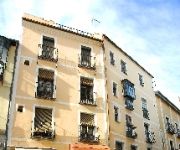Facts and Data
Webpages:
Official Unesco Page
Ciudades Patrimonio de la Humanidad de Expaña
Patrimonio de la Humanidad en España (in Spanish only)
Toledo
City of Toledo (Tourist Office of Spain)
Toledo (World Heritage Cities of Spain)
View photos from OUR PLACE the World Heritage collection
Basis Data:
Unesco World heritage since: 1986
Size of heritage: 260 ha
- Buffer zone: 7,669 ha
Coordinates:
Longitude: -3,971°
Latitude: 39,867°
Summary
Successively a Roman municipium, the capital of the Visigothic Kingdom, a fortress of the Emirate of Cordoba, an outpost of the Christian kingdoms fighting the Moors and, in the 16th century, the temporary seat of supreme power under Charles V, Toledo is the repository of more than 2,000 years of history. Its masterpieces are the product of heterogeneous civilizations in an environment where the existence of three major religions – Judaism, Christianity and Islam – was a major factor.
Location on Map
Show bigger map on Openstreetmap
Historic City of Toledo: A Timeless Gem in Spain
The Historic City of Toledo, located in the Province of Toledo within the Autonomous Community of Castile-La Mancha, is a UNESCO World Heritage site that showcases the rich history and cultural heritage of Spain. With its strategic location atop a hill overlooking the Tagus River, Toledo has been a significant city since ancient times.
Ancient Origins and Roman Influence
Toledo's history dates back to pre-Roman times when it was inhabited by the Carpetani, an ancient Iberian tribe. However, it was during the Roman era that Toledo flourished and gained prominence. The Romans recognized its strategic importance and established a fortified settlement known as Toletum. The city became a major hub for trade and commerce, and its Roman heritage is still visible in the remains of the Roman Circus and the Roman Baths.
A Melting Pot of Cultures
Over the centuries, Toledo witnessed the rise and fall of various civilizations, including the Visigoths, Moors, and Christians. Each culture left its mark on the city, resulting in a unique blend of architectural styles and cultural traditions. The most significant influence can be seen in the city's historic center, where the Christian, Islamic, and Jewish quarters coexist harmoniously.
The Golden Age of Toledo
During the 16th century, Toledo experienced its Golden Age, becoming the capital of the Spanish Empire. This period saw a flourishing of arts, literature, and architecture, with renowned artists such as El Greco leaving their indelible mark on the city. The Cathedral of Toledo, a masterpiece of Gothic architecture, was also constructed during this time and remains one of the city's most iconic landmarks.
Current State and Preservation Efforts
Today, the Historic City of Toledo stands as a testament to its rich and diverse history. Its well-preserved medieval architecture, narrow winding streets, and ancient city walls transport visitors back in time. The city's historic center, enclosed within the walls, is a pedestrian-only zone, allowing visitors to explore its treasures on foot.
Preservation efforts have been paramount in maintaining the authenticity and integrity of Toledo's heritage. The city has implemented strict regulations to protect its architectural treasures, ensuring that any new construction adheres to the traditional style. Additionally, ongoing restoration projects have been undertaken to preserve and restore historic buildings, such as the Alcázar of Toledo and the Monastery of San Juan de los Reyes.
Visitors to the Historic City of Toledo can immerse themselves in its rich cultural heritage by exploring its numerous museums, churches, and synagogues. The Museum of Santa Cruz, the Sephardic Museum, and the Church of Santo Tomé, which houses El Greco's masterpiece "The Burial of the Count of Orgaz," are just a few of the must-visit attractions.
In conclusion, the Historic City of Toledo is a captivating UNESCO World Heritage site that showcases the layers of history and cultural influences that have shaped Spain. Its ancient origins, Roman heritage, and diverse architectural styles make it a truly unique destination. With its well-preserved historic center and ongoing preservation efforts, Toledo continues to enchant visitors with its timeless charm.
Hotels and places to stay
Sercotel Alfonso VI
Almunia de San Miguel
NH Toledo
Mayoral Hotel
Medina de Toledo
Abad Toledo
Carlos V
Toledo Hostal
Domus Plaza Zocodover
Antídoto Rooms Hostal
Videos from the area
Videos provided by Youtube are under the copyright of their owners.

















